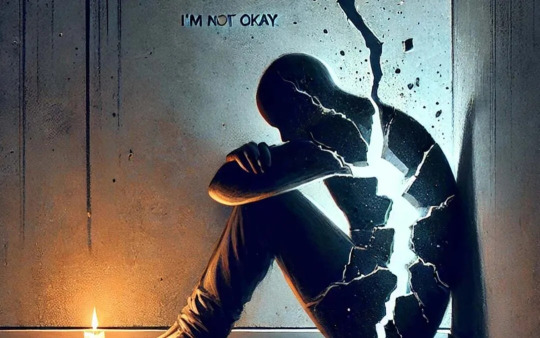Don't wanna be here? Send us removal request.
Text
How to Set Boundaries Without Feeling Like a Bad Person

If you’ve ever felt a knot in your stomach after saying “no” or worried that setting limits makes you selfish, you’re not alone. Boundary guilt is a real struggle, particularly for those of us in recovery from people-pleasing behaviors. Setting healthy boundaries isn’t just acceptable, though; it’s necessary for your relationships, well-being, and self-respect. Let’s discuss how to manage the guilt that frequently accompanies setting boundaries and how to do so without feeling like a bad person.
Why Setting Healthy Boundaries Matters
Boundaries are the invisible lines that protect your emotional, mental, and physical space. They aren’t walls to keep people out, but guidelines that help you maintain your identity, self-esteem, and overall well-being. Without them, relationships can become toxic, and you may feel overwhelmed, resentful, or taken for granted. Setting healthy boundaries allows you to:
Strengthen connections with others
Avoid unhealthy or one-sided relationships
Improve your self-esteem
Protect your mental and physical health
Think of boundaries as acts of self-care, not selfishness.
Understanding Boundary Guilt
When we attempt to establish boundaries, why does guilt surface? It’s frequently a type of “unearned guilt,” which is the belief that you’re doing something wrong when you’re just looking after yourself. Because they are afraid of disappointing, upsetting, or being rejected by others, many people-pleasers have learned to put the needs of others before their own. Because of how uncomfortable this guilt can be, you might give in and stop setting boundaries to avoid it.
The important thing to remember is that feeling guilty does not necessarily indicate that you have done something wrong. It’s usually an indication that you’re moving away from unhealthy habits and toward healthier ones.
Recognize “Fake Guilt”
Not all guilt is legit. Sometimes what you’re feeling is actually fear — fear of conflict, rejection, or disappointing someone — disguised as guilt.
Reminder: Just because someone feels upset doesn’t mean you did something wrong.
Clarify What’s Actually Yours to Carry
You’re responsible for your actions and your boundaries, not for other people’s emotions or reactions.
You can’t control how others will respond to your limits. What you can control is how you communicate them. That’s your lane.
Use Compassionate, Clear Communication
Boundaries don’t have to sound harsh or defensive. You can be kind, clear, and firm at the same time.
Example: “I really appreciate you thinking of me, but I’m not able to take that on right now.”
No overexplaining, no unnecessary apologies.
Anchor Your Boundaries in Your Values
When guilt sneaks in, remind yourself why you’re setting this boundary.
Is it to protect your mental health? Your rest? Your time with loved ones? Write your reasons down. Say them out loud. Text them to a friend.
Reinforcing your “why” keeps you grounded when the guilt voice gets loud.
Practice Self-Compassion
It’s normal to feel weird or guilty when you start setting boundaries, especially if you’re used to people-pleasing.
Tip: Sit with the guilt instead of reacting to it. Acknowledge it: “I feel guilty, and that makes sense because this is new for me.” Then remind yourself: “Feeling guilty isn’t proof I’ve done something bad.”
People-Pleasing Recovery: What to Expect
Getting over people pleasing is a process rather than a final goal. There may be times when you feel more agitated, want to retreat, or second-guess your choices. This is typical. You’ll build better relationships and a stronger sense of self as you practice establishing boundaries.
Reframing the Narrative: Boundaries Benefit Everyone
Keep in mind that setting boundaries benefits not only you but also your relationships. Clear communication of your needs lets others know where you stand, which reduces the likelihood of resentment developing. Respect for one another and genuine connection are made possible by sound boundaries.
Final Thoughts
Establishing sound boundaries is not a sign of selfishness but rather of self-respect. Although feeling guilty is a normal part of the process, it does not indicate that you are a bad person. You can escape people-pleasing and enter a life where your needs are important with practice, self-compassion, and a clear understanding of your values.
Both you and everyone else deserve to be in relationships that respect your boundaries. Contact Us
0 notes
Text
The 3AM Thought Spiral: How to Soothe Your Brain and Finally Sleep

We’ve all been there. It’s 3AM. The world is quiet, your bedroom is dark, and you are meant to be fast asleep, but instead you’re lying awake with your eyes glued to the ceiling having a full-blown existential crisis. One moment you’re speculating whether or not you closed the front door, and the next you’re remembering that cringeworthy thing you said in seventh grade. Ring any bells? Welcome to the infamous 3AM thought spiral.
If you experience anxiety at night, you are not alone. A lot of people report that intrusive thoughts sneak up on them when the world just gets quiet for once. The distractions of the day disappear, and now your mind has concluded it’s the best time to overanalyze everything — your work, your relationships, your life ahead, and even random, irrelevant concerns.
So how do you quiet your mind and even get some sleep? Let’s talk.
Why Does Anxiety Strike Harder at Night?
Before we dive into how to fix it, let’s deconstruct why we’re even doing it in the first place. Our brains are working double shifts during the day processing work emails, errands, conversations, and social media doom-scrolling. We’re being kept engaged, and though it’s exhausting, there’s not a lot of time for deep, pensive (and worrisome) thoughts.
But after dark? All quiet. The mind has nothing to cling to, so it starts going through unresolved anxiety, emotions, and intrusive thoughts you’ve been suppressing. Throw in sleep deprivation and darkness and silence, and your mind is basically an anxiety hotbed.
3AM Thoughts We Don’t Discuss
If you’ve ever been bewildered or mortified about your 3AM thought binges, you’re not alone. Here are some top-of-all-time favorites folks think during those 3AM stints:
“What if I messed up at work and get fired tomorrow?”
“Did I lock the front door? Is the stove off?”
“Why did I say that thing 5 years ago?”
“What if I get ill and nobody’s around to help me?”
“Am I even headed in the right direction in life?”
Ring any bells? Yeah. These bad thoughts thrive on quiet and darkness. But the good news is — you don’t have to get stuck there.
How to Shh Your Brain and Actually Get to Sleep
Here are some simple, practical strategies to help shush your brain when nighttime anxiety starts creeping in:
Do a Mental Download
If your mind is like it’s operating 50 tabs simultaneously, do a brain dump. Have your phone notes or notebook sitting next to your bed. Write down the thought that pops into your head. It doesn’t have to be tidy or coherent — it just has to exit your mind and onto paper (or screen).
This teeny trick makes your brain think that you won’t forget it, and you can deal with it tomorrow when you’re more rested.
Practice the “5-4-3-2-1” Grounding Technique
When intrusive thoughts cannot be held back, grounding in the present moment may be of assistance.
Do the following:
5 things you see
4 things you touch
3 things you hear
2 things you smell
1 thing you taste
It makes your brain focus on sensory facts instead of spiraling.
Master Your Breathing
It’s easy, but your breath is one of the fastest ways to calm your nervous system. When anxiety hits at night, your breath gets shallow and rapid, which alerts your body that something’s wrong — even if it’s just your brain being dramatic.
Try this:
Breathe in for 4 seconds, hold for 7, and blow out for 8.
Do 3–4 cycles. This slows your heart rate and tells your brain it’s safe to relax.
Avoid the Doom-Scroll Trap
It’s so tempting to grab your phone and scroll when you can’t sleep, but looking at that blue light makes it harder for your brain to release melatonin, the sleep hormone. And social media is a terrible place to be when your anxiety is high.
If you must look at your phone, use a blue light filter or stick to calming, non-stimulating programs like a sleep sound program or meditation.
Create a “Wind-Down” Routine
You would never expect a toddler to sleep without a bed routine, but why do we expect it of ourselves? Create a routine that signals your brain to wind down:
Turn off the lights an hour before bedtime
Stretch or practice some light yoga
Listen to soothing music
Drink herbal tea (chamomile’s popular for a reason)
Read a book — not a thriller, please
When your body gets these signals, it will automatically begin to unwind.
Final Thoughts
Nighttime anxiety is extremely common, and while it might feel stifling in the moment, it doesn’t have to control your sleep. Whether it’s nighttime anxiety, intrusive thoughts, or general overthinking, tiny, consistent routines can condition your brain to be at peace at night.
The next time you’re stuck in a 3AM cycle of thought, remember: you’re not strange, you’re not defective, and you’re definitely not isolated. Your brain is simply processing through in an idle moment — and you have tools to assist it in unwinding back to serenity.
Sleep well. You’ve earned it. Contact Us
0 notes
Text
The Guilt Trip You Didn’t Buy a Ticket For: How to Set Boundaries Without Feeling Like the Bad Guy

Have you ever tried to say “no” to someone, only to be met with a look that could melt steel? Or maybe you’ve tried to carve out a little “me time,” but ended up feeling like you just kicked a puppy. If this sounds familiar, you’re not alone. Setting boundaries — especially in toxic relationships — can make even the strongest among us feel like the villain in someone else’s story.
I’ve been there. I know what it’s like to feel the crushing weight of guilt in relationships, especially when you’re just trying to protect your own well-being. But here’s the truth: setting boundaries doesn’t make you the bad guy. In fact, it’s one of the healthiest things you can do for yourself and your relationships.
Why Setting Boundaries Feels So Hard
For a long time, I struggled with saying no. I worried that if I set boundaries, people would think I was selfish, cold, or uncaring. In toxic relationships, this fear is often amplified by manipulation, guilt-tripping, or emotional blackmail. The result? You end up putting everyone else’s needs before your own, and your own happiness takes a back seat.
But here’s what I’ve learned: boundaries are not walls. They’re bridges to healthier, more respectful connections. When you set a boundary, you’re not shutting people out — you’re showing them how to love and respect you.
Recognizing the Signs of Guilt Trips
Toxic relationships often come with their own set of rules — rules that favor the other person’s comfort over your own. If you’ve ever heard phrases like:
“After all I’ve done for you…”
“You’re so selfish for not helping me.”
“If you really cared, you’d do this for me.”
…then you’ve been on a guilt trip you never signed up for.
These tactics are designed to make you question your worth and second-guess your decisions. Recognizing them is the first step to breaking free.
How to Set Boundaries Without the Guilt
Acknowledge Your Feelings
It’s normal to feel guilty at first. I used to beat myself up for days after setting a boundary. But over time, I realized that guilt is just a sign that I’m doing something new and necessary. Allow yourself to feel it — but don’t let it dictate your actions.
Get Clear on Your Needs
Ask yourself: What do I need to feel safe, respected, and happy? Maybe it’s alone time, honesty, or simply being spoken to kindly. Write these needs down. When you’re clear on what you need, it’s easier to communicate it to others.
Communicate Directly and Kindly
You don’t have to be harsh to be firm. Practice saying things like:
“I’m not able to help with that right now.”
“I need some time to myself this weekend.”
“It hurts me when you speak to me that way.”
Stick to “I” statements — they’re less likely to put others on the defensive.
Expect Pushback — Especially from Toxic People
People who benefit from your lack of boundaries will resist when you start enforcing them. That’s not a sign that you’re doing something wrong; it’s a sign that you’re changing the dynamic. Stay strong.
Practice Self-Compassion
Remind yourself: you are not responsible for other people’s feelings or reactions. You’re responsible for your own well-being. It’s okay to put yourself first.
Seek Support
Talk to friends, a therapist, or support groups who understand what you’re going through. Sometimes, just knowing you’re not alone can make all the difference.
The Benefits of Healthy Boundaries
Once I started setting boundaries, something amazing happened. My relationships improved. The people who truly cared about me respected my limits. The toxic relationships? Some faded away — and that was a blessing in disguise.
Contact Us
0 notes
Text
Overcoming Relationship Anxiety: How to Cultivate Trust and Connection

Anxiety in relationships doesn’t always walk in loudly. Sometimes, it slips in like a whisper. A racing heart when they don’t text back fast enough. A creeping sense of doom when they seem quiet or distant. The fear that if you’re too much, too needy, too honest—they’ll leave.
If you’ve felt that tightening in your chest when things are going too well or caught yourself scrolling back through old messages looking for “proof” that something’s wrong, you’re not alone. Relationship anxiety can feel like you’re constantly trying to manage both your partner’s emotions and your own inner chaos. And while it’s deeply human, it can also quietly erode the connection you crave most.
So, how do we untangle anxiety from love? How do we build relationships rooted in trust instead of fear?
Let’s talk about it.
When Love Feels Like a Test
For folks who’ve experienced emotional inconsistency, abandonment, or betrayal—whether in childhood, past relationships, or both—being close to someone can feel like a test you’re terrified to fail. Even when your partner is kind and steady, your nervous system might be stuck in high alert, scanning for any sign that the relationship is about to collapse.
You might find yourself needing constant reassurance. You might avoid conflict at all costs, or swing the other way—testing your partner to see if they’ll stay when things get hard. These behaviors are often misread as “clingy” or “dramatic,” but really, they’re protective strategies rooted in past wounds. It’s not about being difficult; it’s about being scared.
That fear isn’t your fault. But it does deserve your attention.
The Role of Communication
Open, honest communication is one of the strongest antidotes to anxiety in relationships. Not the kind where you try to manage or fix your partner’s reactions—but the kind where you let yourself be seen.
This might sound simple, but when you’re used to hiding your feelings to avoid rejection, speaking your truth can feel like standing in front of a firing squad. It might look like saying:
“I noticed I got anxious when you didn’t respond earlier. I’m working on it, and I just wanted to be honest about where my mind went.”
“Sometimes I worry I’ll push you away if I ask for reassurance. Can we talk about how we handle that together?”
These aren’t easy sentences. But they open the door to connection, vulnerability, and co-regulation. They also invite your partner into your experience instead of pushing them away with assumptions or silence.
And for those on the other side—hearing your partner’s anxiety without personalizing it is its own skill. Reassurance isn’t enabling when it comes from a place of partnership. It’s safety. It’s saying, I see you, and I’m here.
The Importance of Self-Reflection
Trust is a two-way street, but it starts from within. Often, we ask our partners to provide a sense of safety we haven’t yet offered ourselves.
Self-reflection doesn’t mean blaming yourself for your anxiety. It means getting curious. Where did this fear start? What parts of you still believe you’re not worthy of consistent love? What moments from your past are replaying in your present?
This kind of inner work helps separate now from then. It allows you to say, This fear makes sense—but it’s coming from a place that’s older than this relationship.
When you understand your triggers, you can start responding instead of reacting. And from that place, you can ask for what you need in ways that invite closeness rather than conflict.
Rebuilding a Felt Sense of Safety
Anxiety thrives in uncertainty, and relationships naturally come with unknowns. We can’t control another person’s feelings, their past, or their capacity to love us. But what we can control is how we show up—with boundaries, with honesty, and with a willingness to soothe ourselves rather than demand our partner do it all.
This doesn’t mean you handle everything on your own. It means you learn how to regulate your nervous system in healthy ways: through grounding, mindfulness, therapy, or whatever helps you feel anchored. When your body knows it’s safe, it becomes easier to engage with your partner from a place of curiosity rather than panic.
It also becomes easier to discern: Is this relationship actually unsafe, or is my past hurt showing up here? That’s a powerful question—and one that can shift everything.
Love Doesn’t Require Perfection
Here’s the thing: You don’t need to be perfectly healed to be in a healthy relationship. You don’t need to erase all your anxiety or never have a moment of doubt. What you need is a willingness to be real, to sit with discomfort without letting it take the wheel, and to let love in even when it feels unfamiliar.
Trust doesn’t grow overnight. It grows in small moments—when your partner follows through, when you speak up even though you’re scared, when you remind yourself, I’m not in the past anymore.
And connection? That grows in the in-between. In the gentle conversations, the shared laughter, the quiet understanding that even with the mess, you’re still in it together.
Relationship anxiety doesn’t mean you’re broken. It means you’ve been deeply wired for survival, and now, you’re learning something new: how to stay when it’s safe, how to trust love without gripping too tight, how to let someone see you fully and still believe you’re enough.
Because you are. Always.
Contact Us
#trauma#anxitey#teen counseling#emdr therapy#couples therapy#parenting#education#health & fitness#history#eft tapping
0 notes
Text
The High-Functioning Overachiever: When Success Hides Unhealed Trauma

You know the type. Maybe you are the type. The one who’s always got their act together, constantly juggling ten responsibilities like it’s no big deal. The one who gets praised for being “driven,” “reliable,” and “impressive.” The one people admire for their discipline, their work ethic, their ability to always say yes and deliver results.
But here’s the truth that often gets lost behind the degrees, promotions, packed schedules, and pristine Instagram feeds: sometimes, high-functioning overachievers are hurting more than anyone realizes.
Because sometimes, success is a shield.
Sometimes, overachievement is the mask that trauma wears.
The Polished Outside, the Fragile Inside
High-functioning overachievers are often lauded by society. We’re told we’re doing it “right” because we’re productive. But many of us didn’t become this way by chance. We didn’t wake up one day and say, I want to be the best at everything I do, even if it kills me. Instead, for many, the grind started as a survival tactic.
Let me explain.
When you grow up in chaos—whether it’s emotional neglect, abuse, instability, or constant pressure—being “the good one” can be your only safe role. For some, it was the only way to get love, attention, or a tiny sense of control in an uncontrollable environment. You learn to anticipate others’ needs before they speak. You chase perfection, not because you want to impress, but because you’re terrified of what might happen if you don’t.
You become hyper-independent because you learned early on that depending on others led to disappointment, judgment, or even punishment. So you do it all. And you do it well. On paper, you’re thriving. Inside, you might feel chronically anxious, emotionally numb, or deeply exhausted.
But who would know? You’re the strong one. The “resilient” one. The success story.
Overworking as a Trauma Response
Here’s something not enough people are talking about: overworking is often a trauma response.
When your nervous system is stuck in fight-or-flight mode for years, doing becomes a way to quiet the internal noise. You might not feel safe unless you’re busy. You might not feel worthy unless you’re achieving. And the idea of slowing down? Terrifying. Because rest brings stillness, and stillness makes room for the feelings you’ve been trying to outrun.
Burnout isn’t just about long hours and caffeine crashes. For trauma survivors, it’s often about the pressure to prove you’re okay—even if you’re falling apart inside. It’s about outrunning shame, avoiding vulnerability, and hiding the parts of yourself that still feel broken.
This is why it’s so hard to stop. When overachievement is how you’ve coped, letting it go can feel like freefalling.
Perfectionism and the Inner Critic
Perfectionism often feels like a badge of honor—until it turns toxic. For high-functioning trauma survivors, perfectionism isn’t about excellence. It’s about safety.
“If I do everything right, no one can hurt me.” “If I don’t mess up, they’ll finally see I’m enough.” “If I just keep going, I won’t have to feel the emptiness.”
Sound familiar?
The inner critic that drives perfectionism doesn’t just whisper—it shouts. It tells you that rest is lazy, that mistakes are fatal, that you’re never doing enough. It holds you hostage with fear disguised as discipline.
But the truth is, perfectionism doesn’t protect you. It imprisons you. And freedom starts with compassion.
The Path to Healing: Self-Compassion and Nervous System Regulation
So how do you start to unravel the grip of overachievement when it’s been your armor for so long?
Start by noticing. Really noticing.
That tightness in your chest when you try to take a day off? That’s not laziness—it’s your nervous system in fight-or-flight mode, afraid of what stillness might bring. That voice saying “you’re not doing enough”? That’s a scared inner child trying to stay safe the only way they know how.
Now, instead of pushing harder, pause. Breathe into your body. Remind yourself that rest is not a betrayal—it’s a return to safety.
Regulating your nervous system doesn’t have to be elaborate. It can look like:
Placing your hand over your heart and saying, I’m safe now.
Taking three deep, intentional breaths when your mind starts to spiral.
Moving your body slowly and gently to reconnect with your physical self.
Allowing tears to fall when they come—without judgment.
Self-compassion is not fluffy or indulgent—it’s survival work. It’s how we begin to rebuild trust with ourselves after years of outsourcing our worth to productivity.
You Are More Than What You Do
The real you is not your resume, your GPA, your calendar, or your hustle.
The real you is worthy of love and rest, even on your most unproductive day.
The journey to healing as a high-functioning overachiever is messy. You’ll probably feel like you’re failing at “healing” too. But keep going. Let yourself unravel. Let yourself be a human being instead of a human doing.
And maybe—just maybe—success won’t be about how much you accomplish, but how deeply you’ve learned to care for the parts of yourself that were never allowed to rest.
Contact Us
0 notes
Text
The Silent Struggle: What Depression Really Feels Like

Depression is often described as a silent struggle, a battle that rages beneath the surface of our seemingly normal lives. It’s an invisible illness, one that can be hidden behind a mask of productivity and resilience, making it difficult for others to see the depth of our pain. But what does depression really feel like? How does it impact our daily lives, and most importantly, how can we find our way out of this darkness?
In this blog, we’ll explore the invisible nature of depression, its effects on our lives, and how therapy can be a powerful tool in navigating this complex journey.
The Invisible Nature of Depression
Depression is not just about feeling sad; it’s a multifaceted condition that affects every aspect of our lives. It can manifest in different ways, from the more obvious symptoms like persistent sadness and loss of interest in activities, to the less visible signs such as fatigue, irritability, and changes in appetite or sleep patterns.
Why It’s Invisible:
High Functioning Depression: Some people with depression can appear to be functioning normally, even excelling in their roles, while secretly struggling with symptoms like mood swings, self-esteem issues, and lack of energy.
Hidden Depression: This form of depression is characterized by physical complaints or behavioral changes rather than overt emotional symptoms, making it hard to recognize both for the individual and those around them.
What Does Depression Feel Like?
Living with depression can feel like being trapped in a never-ending storm. Here are some personal insights into what it’s like:
Emotional Overload: It’s like carrying a heavy weight that you can’t put down. Every emotion feels amplified, from sadness to anger, making it hard to find balance.
Loss of Interest: Activities that once brought joy now feel like chores. You might find yourself withdrawing from social events or hobbies, not because you don’t want to participate, but because the energy to do so seems nonexistent.
Physical Symptoms: Depression can manifest physically as chronic pain, digestive issues, or unexplained fatigue. These symptoms can be as debilitating as the emotional ones, making everyday tasks feel like climbing a mountain.
Isolation: Despite being surrounded by people; you might feel incredibly alone. The fear of being a burden or the shame of not being “okay” can keep you from reaching out for help.
How Therapy Can Help
Therapy is a powerful tool for navigating depression. It provides a safe space to explore your emotions, develop coping strategies, and work through underlying issues contributing to your depression.
Types of Therapy for Depression:
Cognitive Behavioral Therapy (CBT): Helps you identify and change negative thought patterns that contribute to depression.
Interpersonal Therapy (IPT): Focuses on improving relationships and communication skills, which can be affected by depression.
Mindfulness-Based Therapies: Encourage present-moment awareness and nonjudgmental acceptance of thoughts and emotions.
Benefits of Therapy for Depression
Therapy offers numerous benefits for individuals dealing with depression:
Long-Lasting Results: Therapy provides tools to manage depression not just in the short term but also in the long run, helping prevent future episodes.
Holistic Approach: It addresses both the emotional and physical aspects of depression, promoting overall well-being.
New Perspective: Therapy helps you understand yourself better, challenging negative thought patterns and fostering a more compassionate self-view.
Support Network: Building a relationship with a therapist can provide a sense of security and support, reducing feelings of isolation.
Combining Therapy with Other Treatments
For some, therapy alone might not be enough. Combining it with medication can offer a more comprehensive approach to managing depression.
Benefits of Combined Therapies:
Enhanced Effectiveness: Medication can alleviate symptoms quickly, while therapy helps address underlying issues.
Faster Relief: The combination can provide faster relief from symptoms compared to using either treatment alone.
Reduced Relapse Rates: Studies show that combining therapy and medication can lower the risk of future depressive episodes.
Conclusion
Depression is a silent struggle, but it doesn’t have to be a solitary one. By acknowledging its invisible nature and seeking help through therapy, we can begin to heal and find our way back to a life filled with purpose and joy. Remember, depression is not a sign of weakness; it’s a sign that you’re strong enough to face your challenges head-on.
Contact Us
0 notes
Text
Healing for Trauma & Stress: A Discussion with Nicky & Dr. Lauren
youtube
Nicky Cameron, Trauma Resolution Therapist, and Dr. Lauren Decicco, DPT, discusses their new collaboration at Emergent Counseling. Together, they provide specialized care for individuals struggling with nervous system dysregulation, insomnia, severe depression, anxiety, and toxic stress. Learn how their integrative approach—combining somatic therapy, EMDR, brainspotting, and body-based interventions—helps clients achieve deep healing, restore balance and resilience.
Contact Us
0 notes
Text
Healing Your Inner Child: Why It’s Never Too Late to Grow

We’ve all heard the saying, “Time heals all wounds.” But what if I told you that some of our most significant wounds stem from our childhood? These early experiences often shape our beliefs, behaviors, and emotional responses as adults, even though we may not consciously realize it. That’s where the concept of “inner child work” comes into play—a powerful tool for healing those unresolved childhood issues that can still impact us today.
In this blog, I’ll dive into why healing your inner child is crucial and how it can help you grow, no matter your age.
The Unseen Impact of Childhood Wounds
We all go through tough times as kids—whether it’s dealing with family struggles, bullying, neglect, or simply not having our emotional needs met. As children, we don’t have the tools to fully understand or process these experiences. Instead, we internalize them, which can create deep emotional wounds that we carry into adulthood.
These unresolved childhood issues often show up in our adult lives in subtle (and sometimes not-so-subtle) ways. Perhaps you struggle with low self-esteem, anxiety, or chronic relationship issues. Maybe you find yourself repeating the same patterns or making choices that don’t serve your highest good. In many cases, these behaviors are rooted in unresolved wounds from your inner child.
Think of it this way: If a child falls off their bike and no one is there to comfort them, they might develop a fear of bikes later on. They might even carry this fear into adulthood without fully understanding where it came from. Similarly, when we experience emotional pain in childhood, without the proper support or understanding, that pain can remain locked in our subconscious, influencing the way we react to life as adults.
What Is Inner Child Work?
Inner child work is a therapeutic practice that involves reconnecting with and healing the wounded child within. It’s about acknowledging those past hurts, offering compassion to that younger version of yourself, and providing the love and care that might have been missing back then. Inner child work can be transformative because it helps you address the root causes of your emotional struggles and empowers you to release long-held patterns that no longer serve you.
At its core, inner child work allows you to:
Understand the origins of your pain: By reflecting on past experiences and reconnecting with your inner child, you can identify where certain fears, insecurities, and limiting beliefs started. This clarity helps you understand your adult behavior and responses in a new light.
Reparent yourself: Often, inner child work is about becoming the loving, supportive parent you may not have had. It’s about offering yourself the care, validation, and love that you missed out on as a child. By learning to reparent yourself, you can heal old wounds and develop healthier emotional habits.
Cultivate self-compassion: The process of working with your inner child is deeply compassionate. It encourages you to treat yourself with kindness, patience, and understanding—something that many of us were never taught to do growing up. When we’re kinder to ourselves, we open the door to healing and growth.
How Unresolved Childhood Issues Affect Us as Adults
As adults, unresolved childhood issues can influence many aspects of our lives. They might manifest in the following ways:
Emotional Reactivity: If we’ve experienced neglect, trauma, or invalidation in childhood, we may find ourselves reacting disproportionately to certain situations as adults. For example, small disagreements with a partner could trigger intense feelings of abandonment or rejection, which stem from childhood experiences.
Relationship Patterns: Often, the relationships we had growing up (with our parents, caregivers, or peers) set the stage for how we approach relationships as adults. If we were taught to suppress our emotions or never felt safe to express our needs, we might struggle with intimacy or feel unworthy of healthy, loving relationships.
Self-Worth: If our childhood was filled with criticism or neglect, we might have internalized the belief that we are unworthy or not good enough. This can lead to low self-esteem, people-pleasing behaviors, or a constant need for external validation.
Fear of Vulnerability: Many people who experienced emotional or physical harm as children develop a fear of vulnerability. They may close themselves off emotionally, avoiding intimacy or refusing to express their true feelings to protect themselves from potential pain or rejection.
The Benefits of Healing Your Inner Child
The journey of inner child healing isn’t always easy, but the rewards are well worth it. Here are just a few of the benefits that come with reconnecting with and healing your inner child:
Increased Emotional Awareness: When you begin to heal your inner child, you’ll likely experience a greater awareness of your emotions. You’ll better understand the triggers that cause you to react in certain ways, and you’ll be able to navigate those emotions with more control and insight.
Healthier Relationships: As you heal your inner child, you’ll develop a stronger sense of self-worth and healthier boundaries. This will positively impact your relationships, as you’ll be able to approach them from a place of emotional maturity and self-love, rather than fear or insecurity.
Freedom from Past Patterns: Inner child work can help you break free from old patterns that no longer serve you. Whether it’s unhealthy coping mechanisms, destructive habits, or limiting beliefs, this work can help you rewire your brain and create new, empowering patterns of behavior.
A Deeper Connection with Yourself: The more you work with your inner child, the more you’ll reconnect with your authentic self. You’ll rediscover what makes you feel alive, what you’re passionate about, and what brings you joy. This can lead to a more fulfilling and meaningful life.
Healing Isn’t Just for the Young
One of the most beautiful aspects of inner child work is that it’s never too late to start. Whether you’re in your 20s, 40s, or even 70s, you can still heal your inner child and create the life you deserve. The process might take time, and it might bring up some painful memories, but it’s worth it.
By healing your inner child, you open up the possibility for profound transformation. You allow yourself to move beyond the limiting beliefs and emotional wounds that have been holding you back. Most importantly, you give yourself permission to grow, evolve, and thrive—no matter what age you are.
If you’re feeling stuck or unsure about how to begin, consider working with a therapist who specializes in inner child healing. They can guide you through the process, providing the support and tools you need to nurture and heal that younger part of yourself.
Remember, healing is not a destination; it’s a journey. And on this journey, it’s never too late to grow.
Contact Us
0 notes
Text
The Power of Saying ‘I’m Not Okay’ – And Why It’s Okay

Saying “I’m not okay” is a simple yet profound statement that requires immense courage. It’s an act of vulnerability, a willingness to open up about our struggles and admit that we need help. In a world where strength is often associated with resilience and independence, acknowledging vulnerability can feel counterintuitive. However, it’s precisely this vulnerability that holds the key to healing, deeper connections, and personal growth.
In this blog, we’ll explore the strength in vulnerability, why opening up about our struggles is crucial, and how it can transform our lives, whether in therapy or with loved ones.
The Strength in Vulnerability
Vulnerability is often misunderstood as weakness, but it’s actually a powerful tool for building resilience and fostering meaningful relationships. When we allow ourselves to be vulnerable, we open the door to genuine connections and understanding. This is because vulnerability involves sharing our true selves, including our fears, insecurities, and emotions, without knowing how others will react.
Why Vulnerability Matters:
Deeper Connections: Vulnerability helps us connect with others on a deeper level, fostering empathy and understanding.
Personal Growth: By embracing vulnerability, we confront our fears and insecurities, leading to greater self-awareness and confidence.
Healing: Opening up about our struggles allows us to process and release pent-up emotions, which is essential for healing and mental well-being.
Opening Up in Therapy
Therapy provides a safe and supportive environment where vulnerability can flourish. By sharing our innermost thoughts and emotions with a therapist, we begin to break down the walls that have kept us isolated from our true feelings and from others.
Benefits of Vulnerability in Therapy:
Emotional Release: Vulnerability allows for emotional release, which is crucial for processing and healing from past traumas or stress.
Self-Acceptance: Through vulnerability, we develop a greater acceptance of ourselves, including our flaws and imperfections.
Therapeutic Alliance: Building trust with a therapist enhances the therapeutic relationship, which is vital for successful treatment outcomes.
Opening Up with Loved Ones
Sharing our struggles with loved ones can be just as transformative as it is in therapy. When we open up, we invite others to understand us better, fostering intimacy and trust in our relationships.
Tips for Opening Up:
Choose the Right Moment: Find a comfortable and private setting where you feel safe expressing your emotions.
Be Honest and Clear: Share your feelings directly, using “I” statements to express how you feel without blaming others.
Prepare for Different Reactions: Understand that others may need time to process what you’ve shared, and reassure them that it’s okay to not have all the answers.
Why Saying ‘I’m Not Okay’ Matters
Saying “I’m not okay” is more than just a statement—it’s an acknowledgment of our humanity. It’s a recognition that we all struggle at times and that seeking help is a sign of strength, not weakness.
The Impact of Opening Up:
Reduces Stigma: Sharing our struggles helps normalize mental health discussions, reducing stigma and encouraging others to seek help.
Builds Support Networks: By opening up, we create a support system of people who understand and can offer help when needed.
Fosters Resilience: Vulnerability helps us develop resilience by confronting our fears and learning to cope with challenges.
Conclusion
Saying “I’m not okay” is a powerful act of vulnerability that opens the door to healing, deeper connections, and personal growth. Whether in therapy or with loved ones, embracing vulnerability allows us to confront our fears, build meaningful relationships,
Contact Us
0 notes
Text
What’s Your Nervous System Telling You? The Power of Somatic Release in Therapy

As we navigate the complexities of life, it’s easy to overlook one of our most powerful allies: our nervous system. Often, we find ourselves caught up in thoughts and emotions without realizing how deeply they are intertwined with our physical sensations. This is where somatic therapy comes in—a powerful approach that helps us tap into the mind-body connection, releasing stored emotions and tension that can hold us back from living our best lives.
In this blog, we’ll delve into the world of somatic therapy, exploring how it works, its benefits, and how it can transform your relationship with your body and emotions. Whether you’re dealing with anxiety, trauma, or simply looking to enhance your well-being, somatic release offers a holistic path to healing and self-awareness.
Introduction to Somatic Therapy
Somatic therapy is rooted in the understanding that our bodies store memories and emotions, often manifesting as physical tension or pain. This approach recognizes that traditional talk therapy might not be enough to address the deep-seated physical responses linked to traumatic experiences or stress. By focusing on body awareness and physical sensations, somatic therapy provides a unique way to process and release these stored emotions, promoting a profound sense of healing and balance.
Key Principles of Somatic Therapy
Mind-Body Connection: Somatic therapy emphasizes the intrinsic link between our thoughts, emotions, and physical sensations. It helps us understand that our bodies are not just passive recipients of emotional experiences but active participants in how we feel and respond to the world.
Body Awareness: This involves becoming more attuned to our bodily sensations, such as tension, relaxation, or pain. By paying attention to these physical cues, we can better understand our emotional states and begin to release stored tension.
Holistic Healing: Unlike traditional therapies that focus solely on the mind, somatic therapy integrates psychotherapy and physical therapy to address emotional issues linked with physical sensations. This holistic approach fosters a deeper connection with our bodies, leading to more comprehensive healing.
Techniques Used in Somatic Therapy
Somatic therapy employs a variety of techniques to enhance body awareness and facilitate emotional release. Some of the most effective methods include:
Breathwork: Deep breathing exercises help regulate the nervous system, promoting relaxation and increasing awareness of bodily sensations. By focusing on the breath, individuals can enter a state of calm, making it easier to identify and release trapped emotions.
Body Scanning: This involves slowly bringing attention to each part of the body to notice sensations, tension, or areas of relaxation. Body scanning enhances body awareness and helps identify where stress is being held.
Movement and Dance: These non-verbal tools allow individuals to explore and express emotions, releasing tension and enhancing the mind-body connection. Movement can be a powerful way to unearth emotions that are difficult to articulate.
Touch and Bodywork: Techniques like massage or gentle touch can help release physical tension stored in muscles and tissues, facilitating emotional healing.
Titration and Pendulation: These techniques involve gradually introducing small amounts of traumatic material or sensations, alternating between states of distress and calm. This helps build tolerance for uncomfortable sensations without becoming overwhelmed.
Resourcing: Identifying internal and external resources that provide a sense of safety and strength helps individuals cope with stressors. This can include positive memories, personal strengths, or supportive relationships.
Benefits of Somatic Therapy
The benefits of somatic therapy are multifaceted, offering a transformative approach to mental and physical well-being:
Emotional Regulation: By increasing awareness of bodily sensations, individuals can better manage their emotional responses, reducing anxiety and stress.
Trauma Release: Somatic therapy is particularly effective in addressing trauma, helping the nervous system process and release stored fear and tension.
Improved Physical Health: Releasing physical tension can alleviate chronic pain and other physical symptoms linked to emotional distress.
Enhanced Mind-Body Connection: Somatic therapy fosters a deeper understanding of how thoughts and emotions impact the body, leading to greater self-awareness and self-acceptance.
Working with a Somatic Therapist
A somatic therapist plays a crucial role in guiding individuals through the process of somatic release. Their expertise helps develop awareness of bodily sensations, teach safety in recalling thoughts and emotions, and facilitate emotional release. The relationship between a client and a somatic therapist is built on trust and comfort, essential for effective healing.
Personal Reflections on Somatic Therapy
As someone who has experienced the benefits of somatic therapy firsthand, I can attest to its transformative power. It’s amazing how often we overlook the subtle cues our bodies give us—tension in the shoulders, a knot in the stomach, or a racing heart. These physical sensations are not just random; they are our body’s way of communicating with us, telling us about our emotional state and what we need to heal.
Through somatic therapy, I’ve learned to listen more intently to my body. I’ve discovered how certain memories or situations can trigger physical responses, and how acknowledging these sensations can lead to profound emotional release. It’s a journey of self-discovery, one that requires patience, curiosity, and a willingness to explore the depths of our mind-body connection.
Conclusion
Somatic therapy offers a powerful tool for anyone seeking to deepen their understanding of themselves and release stored emotions and tension. By tapping into the mind-body connection, we can unlock a more holistic approach to healing, one that addresses both the physical and emotional aspects of our experiences.
Whether you’re dealing with trauma, anxiety, or simply looking to enhance your well-being, somatic release provides a transformative path forward. It’s time to listen to what your nervous system is telling you and embark on a journey of self-awareness and healing.
Contact Us
0 notes
Text
How to Say ‘No’ Without Feeling Like a Terrible Person

Have you ever found yourself saying “yes” to something you really didn’t want to do, just to avoid feeling guilty? Trust me, I’ve been there more times than I can count. It’s like a reflex – someone asks for a favor, and before I know it, I’m nodding my head and committing to yet another task that’ll leave me feeling overwhelmed and resentful. But here’s the thing: learning to say “no” isn’t just okay, it’s essential for our mental health and overall well-being. So, let’s dive into how we can master the art of saying “no” without feeling like we’re letting the world down.
Understanding the Power of ‘No’
First things first, we need to recognize that saying “no” is not a negative act. In fact, it’s quite the opposite. When we say “no” to things that don’t align with our values or priorities, we’re actually saying “yes” to ourselves. It’s about setting boundaries and protecting our time and energy for what truly matters to us.
Think about it this way: every time you say “yes” to something, you’re inevitably saying “no” to something else. Maybe it’s that quiet evening you were looking forward to, or the project you’ve been meaning to start. By learning to say “no” more often, we’re actually opening up space for the things that bring us joy and fulfillment.
The Guilt Factor: Why We Struggle
Now, I know what you’re thinking. “But I feel so bad when I turn people down!” Trust me, I get it. The guilt can be overwhelming. We’re often conditioned to believe that saying “no” is selfish or unkind. But here’s a little secret: it’s not.
Feeling guilty about saying “no” often stems from a fear of disappointing others or being perceived as unhelpful. We worry that we’ll damage relationships or miss out on opportunities. But in reality, constantly saying “yes” when we want to say “no” can lead to burnout, resentment, and even damage to those very relationships we’re trying to protect.
Strategies for Saying ‘No’ Gracefully
So, how do we actually go about saying “no” without feeling like we’re crushing someone’s dreams? Here are some strategies I’ve found helpful:
Be Clear and Direct
When saying “no,” it’s important to be clear and direct in your response. Avoid using ambiguous language that might leave room for misinterpretation. Instead of saying “I’m not sure if I can,” try “I’m unable to take on this additional responsibility at the moment.” This leaves no room for doubt and asserts your boundaries effectively.
2. Offer an Alternative (If Possible)
If you genuinely want to help but can’t fulfill the request as it stands, consider offering an alternative solution. For example, if a friend asks you to help them move on a day you’re not available, you could say, “I can’t help on Saturday, but I’d be happy to come by on Sunday afternoon for a few hours if that would be helpful.
3. Use “I” Statements
Frame your response using “I” statements to express your perspective. This helps to avoid sounding accusatory and keeps the focus on your own needs and limitations. For instance, “I have prior commitments that I need to honor” sounds better than “You’re asking too much of me.
4. Practice Self-Reflection
Before responding to a request, take a moment to consider what you’re saying “yes” to and what you might be saying “no” to as a result. This self-awareness can help you make decisions that align with your priorities and values.
5. Remember, It’s Okay to Take Time
If you’re unsure about a request, it’s perfectly fine to ask for time to think it over. You could say, “Can I get back to you on that? I need to check my schedule/commitments first.” This gives you space to consider the request carefully and formulate a thoughtful response.
The Benefits of Saying ‘No’
Learning to say “no” can have profound effects on your life. Here are just a few benefits:
Reduced Stress: By not taking on more than you can manage, you decrease your stress levels, leading to better mental health6.
Increased Happiness: Prioritizing your own needs can lead to a greater sense of fulfillment and happiness.
Empowerment: Each time you say no, you gain a little more control over your life. This empowerment can lead to a stronger sense of self and resilience.
A Personal Note
I remember the first time I really stood my ground and said “no” to something I didn’t want to do. It was terrifying in the moment, but afterwards? I felt like I could conquer the world. That small act of setting a boundary gave me a sense of control over my life that I hadn’t experienced before.
Since then, I’ve been practicing saying “no” more often, and you know what? The world hasn’t fallen apart. In fact, my relationships have improved because I’m no longer harboring resentment over commitments I didn’t want to make in the first place. I have more time for the things I love, and I feel more authentic in my interactions with others.
Wrapping Up
Remember, saying “no” is not about being selfish or unkind. It’s about honoring your own needs and boundaries. It’s about creating space in your life for the things that truly matter to you. So the next time you’re faced with a request that doesn’t align with your priorities, take a deep breath and remember: it’s okay to say “no.”
Practice makes perfect, so start small. Say “no” to something low-stakes and work your way up. With time, you’ll find that saying “no” becomes easier, and you’ll start feeling less like a terrible person and more like someone who values their time and energy.
Here’s to saying “yes” to ourselves by learning to say “no” to others when necessary. You’ve got this!
Contact Us
0 notes
Text
Therapy Isn’t Just Talking: Exploring Somatic Therapy & Body-Based Healing

Have you ever felt like traditional talk therapy just wasn’t cutting it? Like there was something missing, some deeper level of healing that words alone couldn’t reach? Well, you’re not alone. As someone who’s been on both sides of the therapy couch, I’ve experienced firsthand the limitations of purely verbal approaches to healing. That’s why I’m excited to dive into the world of somatic therapy with you today.
What is Somatic Therapy?
Somatic therapy, also known as somatic experiencing (SE) therapy, is a revolutionary approach to healing that focuses on the mind-body connection. Unlike traditional talk therapy, which primarily engages the “higher” parts of the brain, somatic therapy takes a “bottom-up” approach, starting with the more primitive parts of the brain and the body itself.
The term “somatic” comes from the Greek word “soma,” meaning “body.” This therapy is all about tuning into your physical sensations and using them as a gateway to healing emotional and psychological issues.
How Does Somatic Therapy Work?
Now, you might be wondering, “Okay, but how does this actually work?” Great question! Somatic therapy is based on the idea that trauma and stress are stored not just in our minds, but in our bodies too. When we experience something overwhelming, our body’s alert system can get stuck in a hyper-reactive state.
In a somatic therapy session, your therapist will guide you to tune into your body’s responses and physical sensations. This might include noticing things like:
Tightness in your chest
Tension in your muscles
Changes in your breathing
Warmth or coolness in different parts of your body
By becoming aware of these sensations, you can start to release the stored trauma and bring your nervous system back into balance.
Techniques Used in Somatic Therapy
Somatic therapy isn’t a one-size-fits-all approach. There are various techniques that a therapist might use, depending on your specific needs. Some of these include:
Breathwork: Focusing on your breath can help regulate your nervous system and bring you into the present moment.
Gentle Movement: Simple physical movements can help release tension and stored trauma in the body.
Grounding Exercises: These help you feel more connected to your body and the present moment, which is especially helpful if you tend to dissociate.
Body Awareness: Learning to pay attention to physical sensations can help you recognize and address stress or trauma responses more effectively.
Imagery: Using mental images can help process trauma and connect with deeper emotions.
The Benefits of Somatic Therapy
Now, let’s talk about why you might want to give somatic therapy a try. The benefits can be pretty amazing:
Reduced Physical and Psychological Discomfort: Many people report decreased pain, stress, and negative emotions.
Improved Emotional Regulation: Somatic therapy can help you manage strong emotions more effectively.
Better Sleep: Many clients find that their sleep quality improves significantly.
Increased Self-Awareness: You’ll likely develop a stronger connection between your mind and body.
Healing from Trauma: Somatic therapy can be particularly effective for addressing PTSD and other trauma-related issues.
Enhanced Relationships: As you become more in tune with yourself, you may find your relationships improving too.
Is Somatic Therapy Right for You?
If you’re considering giving somatic therapy a try, here are a few signs it might be a good fit:
You’ve tried traditional talk therapy but feel like something’s missing
You struggle with anxiety, depression, or trauma-related issues
You often feel disconnected from your body
You’re interested in a holistic approach to healing
You’re open to exploring new ways of understanding yourself
Remember, there’s no one-size-fits-all approach to therapy. What works for one person might not work for another. But if you’re curious about somatic therapy, it might be worth giving it a shot.
Finding a Somatic Therapist
If you’re interested in trying somatic therapy, look for a licensed therapist who has specific training in somatic experiencing or other body-based approaches. Many therapists now offer a blend of traditional talk therapy and somatic techniques, which can provide a comprehensive approach to healing.
Wrapping Up
Therapy isn’t just about talking. Our bodies hold wisdom and have incredible healing potential that we’re only beginning to tap into. Somatic therapy offers a unique approach to healing that honors the deep connection between our minds and bodies.
Whether you’re dealing with trauma, stress, anxiety, or just feeling stuck, somatic therapy might offer the breakthrough you’ve been looking for. It’s not always easy – tuning into our bodies can bring up intense emotions – but the potential for healing and growth is immense.
Remember, healing is a journey, not a destination. Be patient with yourself, stay curious, and don’t be afraid to try new approaches. Your body has a story to tell. Are you ready to listen?
Contact Us
0 notes
Text
Building a Support Network: Community and Connection in the Fight Against Depression

Depression can feel like an isolating battle—one where every step forward feels heavy, and reaching out seems impossible. But here’s the truth: you don’t have to fight it alone. Having a strong support network can make all the difference in navigating the ups and downs of mental health.
In this post, we’ll dive into the importance of social support, how to build or join a supportive community, and the role of therapy in fostering lasting connections. Whether you’re struggling with depression yourself or supporting someone who is, these insights will help you take the next step toward healing.
Why Social Support is Crucial in Overcoming Depression
Depression thrives in isolation. When you’re feeling low, withdrawing from friends, family, and activities may feel like the easiest option. However, research shows that having strong social connections can reduce the severity of depression, increase resilience, and improve overall well-being.
Here’s why support networks matter:
Emotional Validation: Sometimes, just having someone listen without judgment can be a huge relief.
Practical Assistance: Support systems can help with daily tasks that may feel overwhelming.
Encouragement & Accountability: A good support network reminds you that you are valued and encourages you to keep moving forward.
Sense of Belonging: Knowing you’re not alone in your struggles can be incredibly healing.
But how do you find this support if you feel isolated or unsure of where to start? Let’s explore some actionable steps.
How to Build or Join a Supportive Community
Start with the People You Trust
Reaching out can feel intimidating, but you don’t need a huge circle to start. Identify a few people you trust, whether it’s a family member, a close friend, or even a coworker. Let them know what you’re going through and what kind of support you need—whether that’s a listening ear, company on tough days, or just regular check-ins.
2. Join a Support Group
If you don’t feel comfortable talking to those in your immediate circle, consider joining a mental health support group. There are many options available:
Local In-Person Groups: Many community centers, churches, and hospitals offer support groups for those struggling with depression.
Online Support Groups: Websites like 7 Cups, The Mighty, and Reddit’s r/depression provide virtual communities where you can share your thoughts anonymously.
Therapist-Led Groups: Some therapists offer group therapy sessions that provide both professional guidance and peer support. 3. Engage in Community Activities
Social connection doesn’t always have to be about discussing your struggles. Engaging in activities that bring you joy can help combat feelings of loneliness and depression. Consider:
Volunteering for a cause you care about
Joining a book club, yoga class, or art group
Attending local meetups (Meetup | Find Local Groups, Events, and Activities Near You has groups for almost every interest)
Participating in faith-based or spiritual communities
These activities not only create opportunities for connection but also provide a sense of purpose—which is crucial when battling depression.
4. Utilize Social Media Mindfully
While social media can sometimes fuel negative emotions, it can also be a tool for building connections when used wisely. Follow mental health advocates, join Facebook support groups, or connect with positive communities that share your interests.
A few supportive communities include:
@theblurtfoundation on Instagram (mental health awareness)
@nami (National Alliance on Mental Illness)
Facebook groups like “Mental Health Awareness & Support”
Just be mindful to limit your time on platforms that trigger anxiety or negative comparisons.
5. Be Open to New Connections
Making new connections as an adult can be difficult, but small efforts add up. Start conversations with coworkers, chat with neighbors, or reconnect with old friends. Building a network doesn’t happen overnight, but each step forward helps create a safety net of support.
The Role of Therapy in Creating Lasting Connections
Therapy isn’t just about working through problems—it’s also about learning how to build meaningful relationships. A therapist can:
Help you identify negative thought patterns that keep you from reaching out
Teach communication skills to express your needs better
Offer coping strategies for social anxiety or fear of rejection
Encourage you to build self-compassion, making it easier to accept support
If you’re unsure where to start, online platforms like BetterHelp and Talkspace offer virtual therapy options, while Psychology Today’s therapist directory can help you find a local professional.
What to Do If You Struggle to Find Support
If you’ve tried reaching out and still feel alone, don’t give up. Finding the right support system can take time. In the meantime:
Write in a journal—expressing your thoughts can provide emotional release.
Engage in self-care—even small actions like listening to music or taking a walk can improve your mood.
Reach out to a helpline—if you’re in crisis, organizations like Crisis Text Line (text HOME to 741741) and the Suicide & Crisis Lifeline (988 in the U.S.) offer 24/7 support.
Remember, your feelings are valid, and you deserve support. Keep seeking connection, even when it feels difficult.
Final Thoughts: You Are Not Alone
Depression might tell you that no one cares—but that’s a lie. There are people out there who want to support you, whether they’re friends, family, support groups, or mental health professionals.
Building a support network takes time, effort, and sometimes a little trial and error, but it’s one of the most valuable things you can do for your mental health. Start small, be patient with yourself, and keep reaching out—because healing happens together.
💙 If this post resonated with you, consider sharing it with someone who might need support today. Let’s build a community of encouragement and hope.
Contact Us
0 notes
Text
Journaling for Mental Health: A February Guide to Managing Anxiety and Depression

February can be a tough month for mental health. The excitement of the new year has faded, winter blues may be settling in, and for many, the pressure of Valentine’s Day can add to feelings of loneliness or anxiety. If you’re struggling with your mental well-being, know this: you’re not alone, and there are tools to help you navigate these emotions.
One of the most powerful—and underrated—methods for managing anxiety and depression is journaling. Writing down your thoughts, fears, and emotions can be incredibly therapeutic, offering clarity, self-awareness, and even relief. If you’ve never journaled before or have struggled to stay consistent, this guide will help you get started with simple techniques and prompts designed to improve your mental health.
Why Journaling Helps with Anxiety and Depression
Journaling is more than just putting words on a page—it’s a form of self-care, self-discovery, and emotional processing. Here’s how it can help with anxiety and depression:
Releases Negative Thoughts – Getting worries out of your head and onto paper helps you process them, making them feel more manageable.
Reduces Overthinking – Writing slows down racing thoughts, helping you untangle complex emotions.
Tracks Your Progress – Looking back on past entries can help you recognize growth and patterns in your mental health.
Increases Self-Awareness – Journaling helps you understand triggers, emotions, and coping mechanisms more clearly.
Encourages Gratitude – Practicing gratitude journaling can shift your mindset from what’s wrong to what’s going well.
How to Start Journaling for Mental Health
Starting a journaling habit doesn’t have to be overwhelming. Here are some simple steps to ease into it:
Choose Your Medium
Decide whether you want a physical notebook, a digital journal, or even a journaling app. There’s no right or wrong choice—go with what feels easiest and most accessible.
Set a Journaling Routine
Consistency helps, but it doesn’t mean you have to write daily. Start with just a few times a week or whenever you feel overwhelmed. Set a goal that feels realistic—maybe 5 minutes a day or one page per entry.
Write Freely Without Judgment
Your journal is a safe space. You don’t have to worry about spelling, grammar, or making it sound poetic. Let your thoughts flow naturally.
Use Prompts to Get Started
If you’re unsure what to write about, prompts can guide you. Below, I’ve included a list of powerful journal prompts to help you explore your emotions and manage anxiety and depression.
Experiment with Different Journaling Styles
There’s no single “right way” to journal. Try different methods and see what works best for you:
Stream-of-Consciousness Writing – Write whatever comes to mind, without filtering or editing.
Gratitude Journaling – Focus on things you’re thankful for each day.
Cognitive Behavioral Journaling – Challenge negative thoughts by writing them down and reframing them.
Mood Tracking – Use a simple scale (1-10) to track your emotions daily and notice patterns.
Letter Writing – Write letters to your past or future self, or to emotions like anxiety or fear.
February Journal Prompts for Managing Anxiety and Depression
To make journaling even easier, here are some thoughtful prompts specifically designed to help process emotions and improve mental health:
For Managing Anxiety:
What is currently making me feel anxious? Can I control this situation, or do I need to accept it?
What is the worst-case scenario I’m worried about? How likely is it to actually happen?
List 5 things that help calm me when I feel overwhelmed.
What’s one small step I can take today to ease my anxiety?
Write a letter to your anxious self. What would you say to comfort and support yourself?
For Easing Depression:
What’s one thing I accomplished recently, no matter how small?
List 3 things I’m grateful for today.
Describe a moment when I felt truly happy or at peace. What made it special?
What’s one thing I can do today to show myself kindness?
If I could talk to my past self, what words of encouragement would I give?
For Self-Reflection and Growth:
What’s one limiting belief I have about myself? How can I challenge it?
Who or what in my life brings me the most joy? How can I incorporate more of it into my routine?
What do I need to let go of that is no longer serving me?
If I had no fear of failure, what would I pursue?
What are three positive affirmations I can tell myself every day?
How to Stay Consistent with Journaling
If you find yourself struggling to stick with journaling, here are some tips to help you stay on track:
Make It Enjoyable – Light a candle, grab a cozy blanket, or sip tea while you write. Create a comforting atmosphere.
Keep It Simple – Even just a few sentences a day can be beneficial. Don’t pressure yourself to write long entries.
Use a Journal App – If you’re always on the go, apps like Day One or Journey can make journaling more accessible.
Set Reminders – A small notification can nudge you to take a moment for yourself.
Don’t Aim for Perfection – It’s okay to miss days or write messily. What matters is that you’re showing up for yourself.
Final Thoughts
Journaling isn’t a magic fix, but it is a powerful tool for self-awareness and healing. By dedicating just a few minutes a day to writing down your thoughts, you create space to process emotions, reduce anxiety, and find clarity amidst the chaos.
This February, as winter lingers and emotions run high, give yourself the gift of journaling. Let your words be a refuge, a release, and a reminder that you are strong, resilient, and worthy of care.
What are you waiting for? Open that notebook, start writing, and take the first step toward better mental health.
Contact Us
0 notes
Text
Navigating Valentine’s Day with Anxiety: A Guide to Stress-Free Celebrations

Valentine’s Day is supposed to be about love, connection, and appreciation. But for many of us, it can be a stress-inducing, anxiety-filled event that feels more like a test than a celebration. Whether you’re single, in a relationship, or somewhere in between, the pressure to meet expectations—yours or others’—can be overwhelming.
If the thought of February 14th makes your heart race (and not in a good way), you’re not alone. In this guide, we’ll explore strategies to help you manage Valentine’s Day anxiety, set boundaries, and practice self-compassion, so you can navigate the day with ease—on your terms.
Why Valentine’s Day Can Trigger Anxiety
For many, Valentine’s Day brings up feelings of loneliness, unworthiness, or fear of rejection. It can also come with social anxiety, pressure to plan the “perfect” date, or the stress of meeting expectations. The overwhelming emphasis on romantic love in movies, ads, and social media can make it feel like a test of our relationship status or self-worth.
If any of this resonates with you, take a deep breath. Your feelings are valid, and you’re not alone. Now, let’s talk about how to make this day feel more manageable—and even enjoyable.
1. Set Boundaries That Work for You
One of the biggest triggers for Valentine’s Day anxiety is feeling like you have to conform to societal expectations. But guess what? You don’t. This day doesn’t have to look like a rom-com for it to be meaningful.
Here’s how you can set boundaries to protect your mental health:
Say No Without Guilt – If the idea of a big dinner or social gathering overwhelms you, politely decline. You don’t owe anyone an explanation beyond “I’d rather do something low-key this year.”
Limit Social Media Exposure – Scrolling through perfectly curated posts of grand gestures and idealized love can make anyone feel inadequate. Consider taking a break from social media or muting certain keywords to avoid unnecessary comparison.
Communicate With Your Partner (or Friends) – If you’re in a relationship, be open about how you’re feeling. Let your partner know if you’d prefer a quiet evening instead of a big event. If you’re single, make plans with like-minded friends who also prefer a relaxed approach.
2. Embrace Self-Compassion
Valentine’s Day can sometimes amplify our inner critic, making us feel like we’re not enough. It’s important to challenge those thoughts and replace them with kindness toward yourself.
Treat Yourself Like a Friend – If a friend were feeling down on Valentine’s Day, you’d reassure them with kindness. Offer yourself the same compassion.
Practice Affirmations – Replace anxious thoughts with empowering ones:“I am worthy of love and kindness, no matter my relationship status.”“I do not need external validation to feel whole.”“It’s okay to feel anxious. I am doing my best.”
Engage in Self-Care – Do something that makes you feel good, whether it’s watching your favorite show, cooking a comfort meal, journaling, or taking a relaxing bath.
3. Redefine the Meaning of Valentine’s Day
Who says this holiday is only about romantic love? Love comes in many forms—friendship, family, self-love, and appreciation for the little joys in life.
Celebrate Other Forms of Love – Call a family member, write a heartfelt note to a friend, or spend time with a pet.
Make It a Self-Love Day – Treat yourself to a solo date, buy yourself flowers, or indulge in an activity you love.
Do Something That Aligns With Your Values – Volunteer, donate to a cause, or perform a random act of kindness. Love is about connection, and that doesn’t have to mean romance.
4. Plan Ahead to Reduce Stress
Anxiety thrives on uncertainty. Having a plan for how you’ll spend Valentine’s Day can help ease some of the stress.
Make a Self-Care Itinerary – Outline what you’ll do, even if it’s just “watch my favorite movie and order takeout.” Having a plan prevents last-minute anxiety.
Schedule Something to Look Forward To – If the day feels overwhelming, plan an event for later in the week—like a brunch with a friend or a fun outing—so you have something positive to anticipate.
Prepare Responses for Unwanted Questions – If well-meaning people ask about your love life, have a response ready, like, “I’m focusing on myself right now, and it’s been great.”
5. Let Go of Perfectionism
If you’re in a relationship, you might feel pressure to make the day special, even if your heart isn’t in it. But love isn’t measured by extravagant gestures.
Focus on Connection, Not Perfection – A simple, heartfelt conversation is more meaningful than an expensive dinner you can’t afford.
Give Yourself Permission to Celebrate Differently – If your partner prefers a grand gesture and you’d rather stay in, find a middle ground. Relationships thrive on understanding, not just holiday expectations.
6. Remind Yourself: It’s Just One Day
At the end of the day, Valentine’s Day is just that—one day. It doesn’t define your worth, your relationships, or your future. However you choose to spend it, make sure it feels right for you.
Final Thoughts
If Valentine’s Day tends to bring up anxiety, remember: you are not alone, your feelings are valid, and you have the power to set boundaries, practice self-compassion, and redefine the day in a way that serves you. Whether you spend the day with a partner, friends, family, or solo, the most important thing is honoring your own needs.
Love—true, meaningful love—starts with how you treat yourself.
So take a deep breath, release the pressure, and remind yourself that you are enough, today and every day.
Contact Us
0 notes
Text
Science of Gratitude: How Thankfulness Impacts Brain Health

As I sit here, sipping my morning coffee and reflecting on all the things I’m grateful for, I can’t help but marvel at how this simple practice has transformed my life. You see, a few years ago, I was stuck in a cycle of stress and negativity, always focusing on what was going wrong instead of what was going right. That’s when I stumbled upon the science of gratitude, and let me tell you, it’s been a game-changer.
The Gratitude Revolution in My Brain
I remember the day I decided to start a gratitude journal. It felt a bit forced at first, but as I made it a daily habit, something incredible began to happen. I noticed my mood lifting, my stress levels dropping, and a general sense of contentment washing over me. Little did I know, there was a whole lot of fascinating neurosciences happening behind the scenes.
The Brain’s Reward System: A Gratitude Party
When we express gratitude, our brain releases a cocktail of feel-good chemicals, primarily dopamine and serotonin.
These neurotransmitters are like the life of the party in our brain, making us feel happy and content. It’s like giving our brain a little reward every time we say “thank you” or appreciate something in our lives. I noticed this firsthand when I started ending each day by listing three things I was grateful for. Even on my toughest days, this simple act would give me a little mood boost. It was as if my brain was saying, “Hey, good job noticing the positive stuff!”
Stress Reduction: Gratitude as a Natural Chill Pill
One of the most remarkable effects of gratitude is its ability to lower stress levels. When we focus on what we’re thankful for, our brain switches from stress mode to relaxation model.
It’s like telling our brain, “Hey, things aren’t so bad after all! “I used to be a chronic worrier, always anticipating the worst. But as I cultivated a gratitude practice, I found myself better able to handle life’s curveballs. My heart rate would slow, my breathing would deepen, and that knot in my stomach would start to unwind.
Rewiring for Positivity: The Gratitude Workout
Here’s where it gets really exciting. Practicing gratitude actually changes the structure of our brains through neuroplasticity
It’s like we’re giving our brain a workout, strengthening the neural pathways associated with positive thinking. Over time, I noticed that positive thoughts came more naturally to me. It wasn’t that my life had suddenly become perfect; I had just trained my brain to notice the good more readily. This shift in perspective has been nothing short of life-changing.
Putting Gratitude into Practice: My Personal Journey
Gratitude Journaling: Every night before bed, I write down three things I’m grateful for. It could be as simple as a delicious meal or a kind word from a friend.
The Thank You Challenge: I make it a point to genuinely thank at least one person each day. The smile on their face is an added bonus!
Gratitude Meditation: I spend a few minutes each morning focusing on things I’m thankful for. It sets a positive tone for the entire day.
Gratitude Walks: Sometimes, I take a walk and challenge myself to find five things to be grateful for along the way. It’s amazing what you notice when you’re looking for the positive!
The Ripple Effect of Gratitude
What I love most about gratitude is its ripple effect. As I’ve become more grateful, I’ve noticed those around me becoming more positive too. It’s like gratitude is contagious, but in the best possible way! By understanding the science behind gratitude, we can harness its power more effectively. It’s not just about feeling good; it’s about rewiring our brains for long-term happiness and resilience. So, my fellow brain explorers, I challenge you to embark on your own gratitude journey. Start small, be consistent, and watch as your brain – and your life – transform. Trust me, your future self will be incredibly grateful that you did! Remember, every “thank you” is a step towards a happier, healthier brain. And for that, I’m truly grateful.
Contact Us
0 notes
Text
Thankfulness and Giving Back: How Gratitude Inspires Altruism

I’ll never forget the moment it clicked for me. It was a cold December morning, and I was sitting at my kitchen table with a cup of coffee, reflecting on everything I had to be thankful for. Life wasn’t perfect—I had my share of struggles—but in that moment, I felt overwhelmed by gratitude for the people who had supported me, the opportunities I’d been given, and even the small joys like the warmth of my coffee mug on a chilly day. That’s when it hit me: I wanted to give back. I wanted to take this gratitude and turn it into action. If you’ve ever felt that pull—the urge to do something kind for others after reflecting on your own blessings—you’re not alone. There’s a powerful connection between gratitude and altruism, and it’s one that can transform not only your life but also the lives of those around you.
The Science Behind Gratitude and Altruism
It turns out, there’s actual science behind this connection. Studies have shown that practicing gratitude can increase feelings of empathy and compassion, which naturally lead to a desire to help others. When we focus on what we’re thankful for, we’re reminded of the support we’ve received from others, which often sparks a sense of responsibility or a desire to “pay it forward. “For me, this realization came after a particularly tough year when friends and family rallied around me during a difficult time. Their kindness left such an impression on me that I couldn’t help but think about how I could extend that same kindness to someone else in need. Gratitude also shifts our mindset. Instead of focusing on what we lack, we start to see abundance in our lives—whether it’s time, resources, or talents—that we can share with others. And when we give back, it creates a beautiful cycle: helping others often deepens our own sense of gratitude.
My Journey with Giving Back
I’ll be honest—when I first started thinking about giving back, I wasn’t sure where to begin. Should I donate money? Volunteer my time? Join a community group? The options felt overwhelming. But I quickly realized that giving back doesn’t have to be complicated or grandiose; even small acts of kindness can make a big difference. One of my first experiences with giving back was volunteering at a local food bank during the holiday season. I spent an afternoon sorting donations and packing boxes for families in need. It was humbling to see how much these small efforts could mean to someone else. And as I drove home that evening, I felt an incredible sense of fulfillment—a feeling that has stayed with me every time I’ve volunteered since. Over the years, I’ve found other ways to give back that align with my passions and values. For example:
Mentoring: Sharing my knowledge and experiences with younger professionals in my field has been incredibly rewarding.
Community clean-ups: Spending a Saturday morning picking up trash in local parks has given me a sense of pride in my community.
Random acts of kindness: Whether it’s paying for someone’s coffee or leaving an encouraging note for a coworker, these small gestures have brought so much joy—not just to others but also to myself.
Ways to Practice Altruism This Season
If you’re feeling inspired to give back but aren’t sure where to start, here are some ideas:
1. Volunteer Your Time
One of the most impactful ways to give back is by volunteering your time. Look for opportunities in your community—like serving meals at a shelter, tutoring students, or helping out at an animal rescue center. If you’re not sure where to begin, websites like Volunteer Match can help you find local opportunities.
2. Donate to Causes You Care About
If your schedule is tight but you still want to make an impact, consider donating money or resources to organizations that align with your values. Whether it’s contributing to disaster relief efforts or sponsoring a family during the holidays, every little bit helps.
3. Engage in Random Acts of Kindness
Sometimes, the simplest gestures can have the biggest impact. Pay for someone’s coffee in line behind you, leave an extra-generous tip for your server, or write a heartfelt thank-you note to someone who’s made a difference in your life.
4. Organize a Drive
Gather friends or coworkers and organize a donation drive for items like food, clothing, or toys. This is not only a great way to give back but also an opportunity to bring people together for a common cause.
5. Support Local Businesses
Giving back doesn’t always have to mean donating money or volunteering—it can also mean supporting small businesses in your community. Shop local this holiday season or leave positive reviews online for businesses you love.
6. Be There for Someone
Sometimes, giving back is as simple as being present for someone who’s struggling—whether it’s offering a listening ear, checking in with an old friend, or spending time with someone who might be feeling lonely during the holidays.
The Ripple Effect of Giving Back
One thing I’ve learned through my journey is that giving back creates a ripple effect. When you show kindness and generosity toward others, it inspires them to do the same—and before you know it, those ripples have spread far beyond what you could have imagined. For example, after volunteering at the food bank that first year, I shared my experience with friends who were inspired to join me the following season. Together, we were able to make an even bigger impact—and it all started with one small act.
Gratitude Fuels Altruism
The more I practice gratitude and give back, the more I realize how interconnected these two things are. Gratitude reminds us of what we have; altruism allows us to share those blessings with others. And together, they create a cycle of positivity and connection that benefits everyone involved. So this season, as you reflect on what you’re thankful for—whether it’s your health, your loved ones, or even just having food on the table—I encourage you to think about how you can turn that gratitude into action. Whether it’s volunteering at a shelter or simply offering words of encouragement to someone who needs them, every act of kindness matters. Let’s make this season not just about receiving but about giving—and let gratitude guide us every step of the way. Trust me: the joy you’ll feel from helping others will be one of the greatest gifts you’ll ever receive.
Contact Us
0 notes